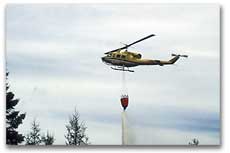
Basic Forest Fire Suppression Course - Online Lessons
LESSON 1 - FIRELINE ORGANIZATION
1.3 Span of Control

Any organizational structure depends on the ability of one person to control the circumstances and perform their function without being overwhelmed. On a smaller incident, this may not become a problem, however a large incident with numerous staff and a large geographical area will require more people with specific responsibilities. The lines of responsibility become blurred in the early stages when one person may be able to handle more than one responsibility. As time continues and the level of responsibility grows, so will a person`s stress level and at some point it will become apparent that the organization needs to change. When that stage occurs, there are 5 principle management functions that need to be employed.
The principle ICS management functions are:
- Command The Incident Commander is responsible for all incident activity. Although other functions may be left unfulfilled, there will always be an Incident Commander.
- Operations Section The Operations section is responsible for directing the tactical actions to meet incident objectives.
- Logistics Section The Logistics section is responsible for providing adequate services and support to meet all incident needs.
- Planning Section The Planning section is responsible for the collection, evaluation, and display of incident information, maintaining status of resources, preparing incident action plan, and incident- related documentation.
- Finances/Admin. The Finance/Administration section is responsible for keeping track of incident related costs, personnel and equipment records, and administering procurement contracts associated with the incident.